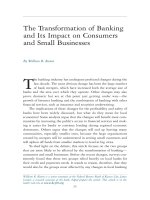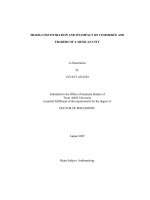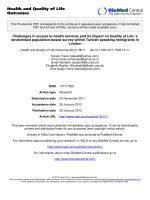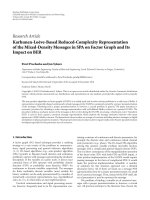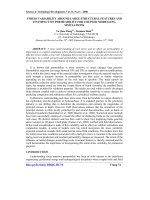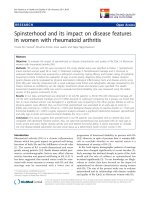The Mass Media and its Impact on Economics_ Meredith M. Price_ The University Of Southern Mississippi
Bạn đang xem bản rút gọn của tài liệu. Xem và tải ngay bản đầy đủ của tài liệu tại đây (291.45 KB, 29 trang )
The Mass Media and its Impact on Economics
The Mass Media and its Impact on Economics
Meredith M. Price
The University Of Southern Mississippi
The Mass Media and its Impact on Economics
2
Abstract
Mass media is suggested to be a catalyst toward economic impact. Studies
posit that media information has either a negative and positive affect, which in turn
can impact individual’s attitude. Consumer behavior research supports the idea that
negative media content on the certain issues can cause the economy to fluctuate.
This paper explores how mass media functions and how media concepts are
related to economic impact. Research in media impact on the economy of the
Mississippi Gulf Coast after the Deepwater Horizon oil spill is the focus of study.
Relating media and it’s impact on the economy is challenging but a necessary factor to
study while in pursuit of understanding other factors in economic impact and media
effects. The behavior of the economy can be impacted by how the media presents
information towards the public.
Introduction of mass media effects
Print, radio, television, Internet, and social networks are common types of
media. Media extends out to large masses of people and provides information to the
public on various subjects, entertain, and to gratify people’s curiosities. As mass media
has expanded and become more obtainable—cell phones, iTouch, and laptops—so
have the influences on a person’s cognitive ability. It would appear that the individual
has become more reliable on consulting the media.
The news media is on a 24 hours and 7 days a week cycle. News is constantly
streaming on the Internet through various websites and blogs. A widely accepted
model of communication is the Westley-MacLean model of communication. It
describes how information is gathered and disseminated to the audience (Severin and
The Mass Media and its Impact on Economics
Tankard, 2001). A closer look at the Westley-Mac Lean model of communication aids
in the study of how the media functions.
The Mass Media and its Impact on Economics
(Figure 1). Westley-MacLean Model of Communication
Westley, B., and M. MacLean. 1957. “A conseptual Model for Communication Research.” Journalism Quarterly,
34:31-38
4
The Mass Media and its Impact on Economics
Westley and MacLean (1955) posit four different participating parties involved
in media communications. The parties are of A (advocacy role), C (communication), B
(receiver), X (objects of orientation), and f (feedback). X’s represent “objects of
orientation” which includes; events, objects, ideas, and people. The Xs are within the
sensory of A, B, and C. The A represents the advocacy roles and observes the Xs and
then transmits purposeful messages about its findings through media.
C represents the communicator responsible for channel roles that are received
by B. An example of this would be television channels, websites, newspapers, etc. C
also functions as a “gatekeeper” which selects information from Xs and A, and strives
to satisfy B’s desire of information. C then chooses what outlet/medium is appropriate
for obtaining information to B roles. Now with the Internet and faster means of
communication, C is able to receive information from several Xs. However, creating
meaning is difficult out of bias/raw information from the Xs; therefore, A is still
necessary for more accurate perception, according to Westley and MacLean (1957). .
The Westley-MacLean model allows messages to be purposive (with the intent
of modifying B’s perception of X) or non purposive (without any intent on the part of
the communicator to influence B) (Severin and Tankard, p. 61, 2001). With B being
perceived as the public or individual groups, they need information about their
environment to help gratify self-satisfaction and help solve problems (Severin,
Tankard, p. 63 2001). The model also provides feedback (f) from the receiver (B) to
The Mass Media and its Impact on Economics
6
the communicator (C) as well as from the communicator (C) back to the advocate (A).
Without this connection of feedback from the different consumers there would be a
lack in information development and in construction information selection.
This model is important in the understanding of how consumers take in news
media and how the different channels, orientations, and advocates can affect
consumer perceptions. This mass communications model aids in understanding how
the different theories of mass media effects could effect economic development.
MEDIA EFFECTS
The effects of mass media are theoretically applicable to the fluctuations in
economic development and are either direct or indirect. McGuire noted several of the
most commonly mentioned intended media effects are; (a) the effects of advertising on
purchasing, (b) the effects of political campaigns on voting, (c) the effects of public
service announcements (PSAs) on personal behavior and social improvement, (d) the
effects of media ritual on social control (McGuire, 1989). McGuire also pointed out the
most commonly mentioned unintended media effects; (a) emotional behavior, (b) the
impact of media images on the social construction of reality, (c) the effects of media
bias on stereotyping, and (d) how media forms affect cognitive activity and style
(McGuire, 1989).
In addition to these media effects, McGuire’s partner, McQuail, summarizes that
the main streams of effects research of other areas of media effects are; (a) knowledge
gain and distribution throughout society, (b) diffusion of innovations, (c) socialization
to societal norms, and (d) institution and cultural adaptations and changes (McQuail
1972). A more in-depth analysis will be explored on specific media effects in this body
The Mass Media and its Impact on Economics
of work.
Media Agenda Setting
The concept of agenda setting set by the media is a likely factor that can
influence economic development. The agenda-setting function of the media refers to
the media’s capability, through repeated news coverage, of raising the importance of
an issue in the public’s mind (Severin, Tankard pg. 219). McCombs and Shaw reported
the first systematic study of agenda-setting hypothesis in 1972.
Findings in McCombs and Shaw’s “Chapel Hill Study” supported that mediaagenda setting can influence political campaigns (1972). Voter perception of a
particular campaign platform was shaped based on what the media choose to
emphasis on. McCombs and Shaw’s data suggested that a strong relationship between
the emphasis placed on different campaign issues by the media and the judgments of
voters are to the salience and importance of various campaign topics (1972).
A precursor to McCombs and Shaw’s hypothesis suggests that what people will
think the facts are, and what most people will regard as the way problems are to be
dealt with is portrayed through the media (Norton Long, p. 260 1958). Also, mass
media forces attention to certain issues and are constantly presenting objects
suggesting what individuals in the mass should think about, know about, have feelings
about (Kurt, Gladys Engle Lang p. 232 1959).
Concepts that the media reported on were economic policy of the different
campaigns (McCombs and Shaw 1972). These reports could influence consumer
confidence. The level of consumer confidence augurs consumer spending— and thus
The Mass Media and its Impact on Economics
8
the future trajectory of the economy— and it affects a variety of political behavior
such as election outcomes, macropartisanship (Erikson, MacKuen, and Stimson 2002),
presidential approval (MacKuen, Erikson, and Stimson 1992, public policy mood (Durr,
1993), congressional approval (Durr, Gilmour, and Wolbrecht 1997), and trust in
government (Chanley, Rudolph, and Rahn 2000).
Additional experiments have been conducted to learn more about the effects of
media agenda setting. Media agenda setting determines the criteria by which an issue
will be evaluated (Iyengar, Kinder, Peters, 1982). This concept is known as priming.
Priming is the process in which media attends to particular issues and not others and
thereby alter the standards by which people evaluate and act on an issue (Severin,
Tankard p 226). The concept of priming builds on the idea that mass media does have
the power to build agendas outside of its own. Therefore, the media acts as a director,
actor, and consumer of it’s own product.
The application of agenda setting and it’s influence on economic development
can be seen in the case study of news coverage on women in the 1996 Olympic games
and how the economy had a slight dip. Newspaper coverage of the 1996 Olympic
games primarily were of women due to the addition of two women’s events debuted
which was soccer and softball, along with women’s mountain biking and beach
volleyball. The media emphasized on women’s progress. Women also were recognized
as an important television audience. NBC, the official U.S. Olympic television network,
sought to deliver on promised rating to advertisers by attracting the largest possible
audience and women were the target (Kinnick, 1998).
The Mass Media and its Impact on Economics
Women decided to follow the Olympic games by watching television rather
than going out and shopping suggests Kinnick. This in turn caused a brief moment of
loss in the month of August in the gross retails sales on a national level. Little growth
in economic activity was seen and some economist believe that the rise in women
viewership of the Olympics set off the slowing of gross retail sales on a national level
(Kinnick, 1998).
Cultivation theory, used in mass media studies, is a concept that explains how
people’s perceptions, attitudes, and values change from consumption of media.
Exposure to the same messages that debut in the mass media produces what
researchers refer to cultivation, or the teaching of a common worldview, common
roles, and common values (Gerbner, Gross, Morgan, and Signorielli, p. 14 1980). Thus,
Media can have a negative impact upon cognitive thinking.
Psychological literature supplements the cultivation theory by suggesting that
unfavorable information has a greater impact on impression than does favorable
information, across a wide variety of situations (e.g., Ronis and Lipinski 1985; Singh
and Teoh 2000; Van der Pligt and Eiser 1980; Vonk 1993, 1996). Stuart N. Soroka’s
(2006) research in media’s effect on economics suggests that there exists an
“asymmetric responses to bad and good economic information”.
Research in economics posits a prospect theory (Kahneman and Tversky 1979).
Prospect theory is a choice under uncertainty, which contains a feature called loss
aversion. People react more fervently towards a loss in utility than they do towards a
gain of equal magnitude (Soroka, 2006). This individual-level loss adverse behavior is
evident in macroeconomic dynamics: consumption tends to drop more when the
The Mass Media and its Impact on Economics
10
economy contracts than rise when the economy expands (Bowman, Minehart, and
Rabin 1999).
Examples in media suggest that overemphasizing the prevalence of violent
crime (e.g., Altheide 1997; Davie and Lee 1995; Smith 1984), and events involving
conflict or crisis receive a greater degree of media attention (Bagdikian 1987; Herman
and Chomsky 1988; Parachos 1988; Patterson 1997; Shoemaker, Danielian, and
Brendlinger 1991). Most relevant to the current analysis, U.S. networks regularly give
more coverage to bad economic trends than to good economic trends (Harrington
1989).
The prominence of negative media coverage may be driven by the same
individual-level theories such as media agenda setting, priming, and framing.
Journalists are individuals, writing articles to appeal to other individuals and thus
regard negative information as more important, not just based on their own interests,
but also on the interests of their news consuming audience (Soroka, 2006).
There is however, an alternative explanation for the prominence of negative
news. It may be that media outlets’ emphasis on negative news reflects one of the
principle institutional functions in democracy: holding current Governments (and
companies, and indeed some individuals) accountable (Carlyle 1841). Therefore, media
is a surveillance that mainly involves identifying problems and at times over
emphasizes negative information. But some scholars think it is the media’s job to do so
(David Lyon, p. 21, 2007).
Surveillance of the media includes economy facts, stock market reports and the
overall well being of a nation (Severin and Tankard, p. 321, 2006). Surveillance
The Mass Media and its Impact on Economics
function can cause several dysfunctions such as panic due to the overemphasis of issues
facing a society. Lazarsfeld and Merton (1948/1960) noted that “narcotizing”
dysfunction when individuals fall into a state of apathy or passivity as a result of too
much information to assimilate may leave many audience members with little
perspective of what is normal.
Studies of media effects on economic fluctuations propose that the 1990
recession, in popular belief, was widely spread by the press’s effect on people’s
pessimism of the general economy (Marcelle Chauvet and Jang-Ting Guo, 2003).
Negative reports on the national economy led to a fall in consumer confidence
(Marcelle Chauvet and Jang-Ting Guo, 2003). 1
In particular, the minutes of the Federal Open Market Committee meeting in
December 1990 pointed to consumer sentiment as one of the principal contributing
factors for this recession. Blanchard (1993) and Hall (1993) both attribute the 1990
recession to a significant drop in consumption, and speculate that consumer sentiment
may have had something to do with it.
Findings conducted by Chauvet and Guo (2003) pointed out that consumption
growth did switch to a low-growth state at the beginning of the 1989 slowing of the
economy (Figure 2). Consumer confidence also fell during the slowing, as observed in
all the previous low-growth phases and recessions (f1) (Chauvet and Guo, 2003).
However, the probabilities of consumer pessimism based on non-fundamentals rose
only in July 1990, which coincided with the onset of this recession (Figure2). The same
1
For example, The New York Times on April 3, 1991, reported a quote by Roger Brinner, director of research at
DRI/McGraw-Hill, that “If consumers hadn’t panicked, there wouldn’t have been a recession.” In addition, the lead
story in The Wall Street Journal on November 4, 1991, was entitled “Economy in the U.S. Isn’t Nearly as Sour as the
Country’s Mood. But Pessimism Could Become Self-Fulfilling Prophecy Further Stalling Recover. Can Attitude Be
Everything?”
The Mass Media and its Impact on Economics
12
pattern was observed for growth in personal income, manufacturing trade and sales,
and employment, whose falls coincided with the beginning of this recession. Therefore,
consumers’ pessimism did not seem to be a source of this recession (Chauvet and Guo,
2003).
However Chauvet and Guo (2003) notes that consumers’ pessimism may have
been an important factor in intensifying and extending the 1989-1992 economic
slowdown. The figures created by Chauvet and Guo (2003) reveal that low
consumption growth phase lagged consumers’ pessimism, and lasted until the end of
the sample in 1995. Thus, the unprecedented extended slowdown could have been a
reflection of consumers’ attitudes toward the economy after the official end of the
1990 economic recession (Chauvet and Guo, 2003).
Chauvet and Guo (2003) proposed at the end of their research that U.S.
recessions and slowdowns could have been responses not to shifts in economic
fundamentals, but to agents’ self-fulfilling pessimism.
The Mass Media and its Impact on Economics
(Figure 2). (f1-f4 clockwise starting top left) The 1990 recession: Probabilities of consumers’ and investors’
pessimism, low
consumption and investment growth states, investment growth, 3-month T-Bill rate, growth
rates of employment, personal income, and sales—NBER recessions (shaded areas) and
slowdowns (- - -).
Marcelle Chauvet . SUNSPOTS, ANIMAL SPIRITS, AND ECONOMIC FLUCTUATIONS. Macroeconomic Dynamics,
Volume 7, Number 1 (February 2003), pp. 140-169, />ArticleID=J8D8D5YBVKD44TTPFUQ6
The Mass Media and its Impact on Economics
14
Self-fulfilling pessimism is the result from news refraction hypothesis suggested
by McLeod and associates (1995). Their hypothesis suggests that local content of news
media exposure could have a strong influence on perceptions of issues and the
“closeness of home”. Therefore, viewer’s doubts suppress the urge for action, and a
reclusive approach is taken towards issues (McLeod et al., 1995).
A study of the media’s impact on the Mississippi Gulf Coast economy after the
Deepwater Horizon oil spill was conducted to support the theory that media can
potentially impact an economy.
The oil spill in the Gulf of Mexico, which began after the Deepwater Horizon rig
explosion on April 20th and continued to leak for another three months was a
challenging event for news media to cover. Unlike most catastrophes, which tend to
break quickly and subside almost as fast, the spill was a slow-motion disaster that
demanded constant vigilance and sustained reporting (journalism.org). Also the
media had to learn how to report on the oil spill by using NOAA (National Oceanic
Atmospheric Administration) maps and by consulting scientist and researchers who
were part of the response team for BP.
The story on a national level consisted of three competing story lines-the role of
BP, the Obama Administration, and the events in the Gulf region. The coverage of the
disastrous saga along affected coastal states was in-depth. Texas, Louisiana,
Mississippi, Alabama, and the Florida pan handle was bombarded with journalists
literally waiting on the beaches and headlining articles about how the oil was an
economic, ecological, and political Armageddon.
To evaluate the coverage, PEJ (Pew Research Center’s Project for Excellence in
The Mass Media and its Impact on Economics
Journalism) studied approximately 2,866 stories about the oil spill produced from April
20 to July 28-from the day that the Deepwater Horizon exploded to the day the BP CEO
Tony Hayard’s departure was announced. From that time, the oil spill was by far the
dominant story in mainstream news media in the 100-day period. It accounted for
22% of the newshole and in the 14 full weeks included in this study, the disaster
finished amount the top three weekly stories 14 times (PEJ, 2010). It registered as the
No. 1 story in nine of those weeks (PEJ, 2010). Figure 3 represents the percent of
newshole coverage.
(Figure 3)
/>
Case Study
The Mass Media and its Impact on Economics
16
A study was conducted of the primary local paper of the Mississippi Gulf Coast.
The Sun Herald ran articles related to the oil spill on a daily since April 22, 2010 until
the end of the research on August 31, 2010. In addition to counting how many articles
appeared in the Sun Herald relating to the Oil spill, a word count of oil/spill was also
conducted (Figure 4). In addition, two other newspapers that are exposed to local
residents were studied. Article counts were conducted on the New Orleans TimesPicayune and the Mobile Press-Register (Figure 4). These two papers also contained
daily articles of the oil spill.
(Figure 4)
Collected newspaper data
The Mass Media and its Impact on Economics
Newspaper
Source
April
24
May
301
June
358
July
301
August
121
Press-Register
33
329
337
284
272
TimesPicayune
12
206
234
181
52
120
1517
2430
1406
567
Sun Herald
Word Count
Sun Herald
Source: Hard copies of each paper
Economic data of Gross retail sales and unemployment rate of the three coastal
counties; Hancock, Harrison, and Jackson, was collected. The months of May, June, July,
The Mass Media and its Impact on Economics
18
and September revealed an increase in unemployment rate (Mississippi Department of
Employment Security, 2010), (Figure 5). The month of August reported a decrease in
the unemployment rate (Figure 6), which related to the increase in BP volunteers for
the month of July when the oil came ashore more abundantly. Also the newspaper
reports less on the oil spill in the months of July and August. If all newspaper articles
were held constant from the previous month, September’s increase in unemployment
though, would prove that little relation exists between media and economic impact
(Figure 7).
(Figure 5)
Collected Data of Article Count/WordCount,
Retail Sales% Change 09-10, Unemployment % Change 09-10
Source: Hard copy of newspaper/Unemployment Rates:
/>
The Mass Media and its Impact on Economics
Mississippi Gross Retail Sales: Mississippi Department of Revenue:
/> /> /> /> /> />
Month
May
June
July
August
News Paper
Sun Herald
Press-Register
TimesPicayune
Article Count
301
329
Sun Herald
Press-Register
TimesPicayune
358
337
Sun Herald
Press-Register
TimesPicayune
301
284
Sun Herald
Press-Register
TimesPicayune
121
272
Word
1517
206
2430
234
1406
181
52
567
County
Hancock
Harrison
2009-2010
Retail Sales %
Change
(-)6.12
(-)7.46
2009-2010
Unemployment %
Change
1.6
2.3
Jackson
(-)8.04
2.4
Hancock
Harrison
(-)14.69
(-)6.95
.9
1.4
Jackson
(-)7.41
1.3
Hancock
Harrison
(-)14.69
(-)10.54
1.2
1.2
Jackson
(-)3.73
1.2
Hancock
Harrison
(-)18.16
1.00
(-)0.3
(-)0.3
Jackson
(-)2.38
(-)0.4
(Figure 7)
Mississippi State Tax Commission
Two-Year Comparison of Gross Retail Sales 2009-2010
The Mass Media and its Impact on Economics
20
Source: Mississippi Gross Retail Sales: Mississippi Department of Revenue:
/> />May
Hancock County
Harrison County
Jackson County
June
Hancock County
Harrison County
Jackson County
July
Hancock County
Harrison County
Jackson County
August
Hancock County
Harrison County
Jackson County
September
Hancock County
Harrison County
Jackson County
October
Hancock County
Harrison County
Jackson County
2009
$663,508,863.87
$4,049,297,147.04
$1,880,907,665.18
2010
$622,871,688.98
$3,747,045,158.16
$1,729,726,459.39
Difference
($40,637,174.89)
($302,251,988)
($151,181,205.79)
(-)6.12%
(-)7.46%
(-)8.04
$720,090,435.01
&4,392,627,311.30
$2,044,062,723.58
$675,428,513.22
$4,087,141,874.45
$1,892,597,535.49
($44,661,921.79)
($305,485,436.85)
($151,465,188.09)
(-)6.20%
(-)6.95%
(-)7.41%
$71,296,099
$379,195,437
%185,656,947
$60,822,315
$419,153,048
%192,584,360
($10,473,784)
($39,957,611)
($6,927,413)
(-)14.69%
(-)10.54%
(-)3.73%
$140,907,979
$751,422,627
$339,872,736
$115,323,203
$758,940,117
$331,777,981
($25,584,776)
$7,517,490
($8,094,755)
(-)18.16%
1.00%
(-)2.38
$165,330,045
$1,073,863,967
$461,196,959
$198,709,060
$1,101,365,019
$484,196,969
($33,379,015)
($27,501,052)
($23,000,010)
(-)16.80%
(-)2.50%
(-)4,75%
($41,234,378)
($27,324,927)
($43,174,154)
(-)16.18%
(-)1.92%
(-)6.65%
$213,678,199
$254,912,577
$1,398,080,157
$1,425,405,084
$605,895,473
$649,069,627
/> /> /> />
(Figure 6)
Unemployment Rate by County
Mississippi Department of Employment Security
%
The Mass Media and its Impact on Economics
May
Hancock
Harrison
Jackson
June
Hancock
Harrison
Jackson
July
Hancock
Harrison
Jackson
August
Hancock
Harrison
Jackson
September
Hancock
Harrison
Jackson
8.0%
7.2%
7.8%
2009
9.6
9.5%
10.2%
2010
% Change
1.6
2.3
2.4
8.3%
7.8%
8.4%
9.2%
9.2%
9.7%
0.9
1.4
1.3
8.4%
8.1%
8.7%
9.6%
9.3%
9.9%
1.2
1.2
1.2
8.0%
7.7%
8.3%
7.7%
7.2%
7.9%
(-)0.3
(-)0.3
(-)0.4
7.9%
7.5%
8.4%
8.7%
8.1%
8.9%
0.8
0.6
0.5
A survey was conducted asking 100 coastal residents: What is the greatest
threat from the oil spill? 78% wrote that the greatest threat was towards the local
economy (figure 8). A pole conducted in October revealed that: 42% believed the
The Mass Media and its Impact on Economics
22
media coverage of the Deepwater Horizon oil spill was a key factor the slowing of the
local economy while 37% believed the national recession was a possibility, 16%
blamed it on Hurricane Katrina, and 5% responded: no opinion (figure 9).
(Figure 8)
The Mass Media and its Impact on Economics
(Figure 9)
“Dead sea turtles wash ashore,” claimed the Sun Herald on May 2, 2010.
The Mass Media and its Impact on Economics
24
Journalist would write articles about the turtles even though their cause of death was
not related to the oil spill, which was proved by marine biologists. These types of
articles began to frequently appear in the local papers such as the Times Picayune of
New Orleans, LA, the Pres-Register of Mobile, AL, and the Sun Herald of Gulfport, MS.
These three papers were of particular interest in this case study because they are the
most consumed papers along the Mississippi Gulf Coast.
The media agenda setting effects began to naturally set in as the oil continued
to gush. Story after story from journalist trying to outdo each other has filled the
wires for years to come of the effects of the oil spill. There was an overreporting of
significant but unusual events. This was an issue in the Santa Barbara oil spill, which
was significant but received exaggerated coverage because of it’s unusualness and
because people enjoy the sensationalism (Severin, Tankard p 232 2001).
Observations suggest the media’s agenda emphasized on gushing oil, dying
wildlife, tainted seafood, and oiled beaches (Sun Herald appendix) the media did not
specifically state that small regions affected. Even though the media was clear in
portraying which areas were being impacted, the content was correct. The effects of
the media on a national level could have possibly impacted people pessimisms and
following with possible economic slowdown suggested by (Chauvet, Guo 2003),
economy (figure 9).
As the surge of media reports on the oil spill flooded the mass media, economic
impact along the Mississippi Gulf Coast experienced little significant growth. Overall,
the oil spill created job losses and also crushed the fishing industry, which had a ripple
effect that reached restaurant nationwide. At the same time though, BP created
The Mass Media and its Impact on Economics
temporary jobs along the gulf states and also occupied hundreds of hotel rooms. These
factors are significant in contributing towards the economic data researched.
Adam Sacks, managing director of Oxford Economics USA mentioned that
“History and current trends indicate a potential $22.7 billion economic loss to the
travel economics of the Gulf Coast states over the next three years could be possible”
(Sun Herald 07/24/2010). Sacks continues, “One of the most cost-effective ways to
mitigate these damages is to immediately fund strategic marketing to counter
misperceptions and encourage travel to the region” (Sun Herald 07/24/2010).
Misperception created by the media is a factor that Sacks mentions in his consulting
towards the Gulf Coast tourism sector.
Conclusion:
Theories support the idea that mass media has significant economic impact.
Media theories such as media agenda setting, priming, framing, and cultural theory
support the concept of how media can impact an economy, however little research has
been conducted on this subject. Economic research supports the idea that sentiments
of the consumer can be affected by media content and therefore could lead to
fluctuations in the economy.
Research posited by Chauvet and Guo (2003), support the idea that an
economic slowdown is impacted by agents’ self-fulfilling pessimism. Studies such as
Soroka’s work (2006) strengthens the argument that; public responses to negative
economic information such as the oil spill, are much greater than are public responses
towards positive information. This suggests that the media’s portrayal of the oil spill

